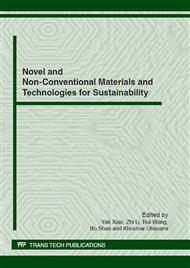p.606
p.611
p.617
p.622
p.628
p.635
p.646
p.653
p.661
Durability Evaluation of Agro-Industrial Waste-Based Particle Boards Using Accelerated Aging Cycling Tests
Abstract:
The degradation of agro-industrial waste-based particle boards reinforced with sugar cane bagasse was evaluated by comparing their physical and mechanical properties. The particle boards were prepared with sugar cane bagasse particles (85% by weight of composite) and mixed with bi-component polyurethane resin based on castor oil (15% by weight). After mixing for 2 to 3 min, the resulting mixtures were pre-pressured. Standard molding conditions were: temperature, 100°C; pressure during heating, 5 MPa; and heating time, 10 min. The dimensions of the particle boards produced in the laboratory were 0.40 m x 0.40 m x 0.01 m. The boards were cut into testing specimens with dimensions 0.25 m × 0.05 m × 0.01 m. The accelerated aging test was carried out based on the ASTM D 1037 standard in order to determine the main factors that cause degradation and to identify their influence. The test consists of cycles of six treatment steps, i.e., immersion in water at 49°C for 1 h, steaming at 93°C for 3 h, freezing at-12°C for 20 h, drying at 99°C for 3 h, steaming at 93°C for 3 h, and drying at 99°C for 18 h. This cycle was applied six times for all specimens. Modulus of rupture (MOR), modulus of elasticity (MOE), internal bonding strength (IB), water absorption (WA%) and thickness swelling (TS%) were measured before and after the cycles of accelerated aging. The performance of the particle boards before accelerated aging presented acceptable mechanical performance, MOR: 21.86 ± 2.16 MPa, MOE: 2.77 ± 0.26 GPa, and IB: 1.18 ±0.40. The performance of the particle boards decreased after accelerated aging showed, MOR: 6.25 ± 0.70 MPa, MOE: 0.52 ± 0.10 GPa, and IB: 0.15 ± 0.07. The results were influenced by the temperature, relative humidity and warm water. After the accelerated aging process, the materials showed mechanical behavior similar to Low-Density grade Particleboard (LD1).
Info:
Periodical:
Pages:
628-634
Citation:
Online since:
June 2012
Price:
Сopyright:
© 2012 Trans Tech Publications Ltd. All Rights Reserved
Share:
Citation:


